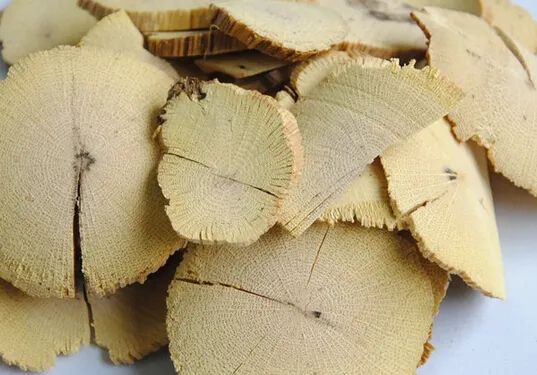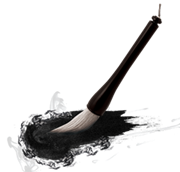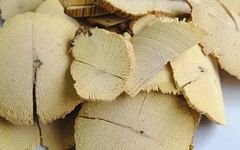Chuan Mu Tong (川木通)

In Traditional Chinese Medicine (TCM), there is a syndrome known as Damp-Heat Syndrome (湿热证), which can arise from both external pathogens and internal injuries. It can be quite troublesome to treat. Famous formulas such as San Ren Tang (三仁汤) and Long Dan Xie Gan Tang (龙胆泻肝汤) are well-known for treating this type of syndrome. However, based on clinical practice, there is an even more effective formula, which is Gan Lu Xiao Du Dan (甘露消毒丹), created by the renowned Qing Dynasty warm disease scholar Wang Shixiong.
Gan Lu Xiao Du Dan is derived from Wang Shixiong’s work Wen Re Jing Wei: Fang Lun (温热经纬·方论), specifically the ninety-fifth formula, and consists of the following ingredients:
Fei Hua Shi (飞滑石) 15 liang, Mian Yin Chen (绵茵陈) 11 liang, Dan Huang Qin (淡黄芩) 10 liang, Shi Chang Pu (石菖蒲) 6 liang, Chuan Bei Mu (川贝母) and Mu Tong (木通) each 5 liang, Huo Xiang (藿香), She Gan (射干), Lian Qiao (连翘), Bo He (薄荷), and Bai Dou Kou (白豆蔻) each 4 liang. All herbs should be dried and ground into a fine powder (exposure to fire will alter the properties of the herbs). The dosage is three qian per serving, mixed with hot water, taken twice daily. Alternatively, they can be made into pills the size of a marble and taken with hot water.
Gan Lu Xiao Du Dan is indicated for: fever, fatigue, chest tightness, abdominal distension, limb soreness, throat swelling, rashes with yellowing of the skin, thirst, red urine, constipation, vomiting, diarrhea, dysentery, turbid urination, sores and ulcers, pale white or thick greasy or dry yellow tongue coating, etc.; it is also indicated for various diseases caused by poor adaptation to the environment.
The key diagnostic points for this formula are: red tongue, yellow greasy coating, throat discomfort, cough, shortness of breath, chest tightness, and abdominal distension.
Analyzing Gan Lu Xiao Du Dan, we find that Huo Xiang aromatically transforms turbidity and disperses dampness in the upper jiao; Bai Dou Kou and Shi Chang Pu aromatically transform and disperse dampness in the middle jiao; Yin Chen, Hua Shi, and Mu Tong drain dampness from the lower jiao; thus, the three jiao are treated to eliminate dampness. Additionally, Bo He, Lian Qiao, She Gan, Huang Qin, and Chuan Bei Mu clear heat and detoxify, soothe the throat, and transform phlegm to treat heat.
This formula has traditionally been limited to treating warm diseases caused by external pathogens, which can also be likened to typhoid fever in Western medicine. However, since the invention of chloramphenicol, this disease has significantly decreased and is rarely seen. Nevertheless, the absence of this disease does not mean that TCM has no application; TCM emphasizes syndromes, and as long as warm-heat syndromes exist, this formula can still be very effective.
Clinically, Damp-Heat Syndrome is not only commonly seen in external pathogens but also in various other conditions.
Conditions such as oral ulcers, bad breath, sore throat, cough, gastritis, hepatitis, jaundice, hair loss, turbid urination, and ulcers, as long as they manifest as Damp-Heat Syndrome, I will primarily use this formula with modifications, and the results are remarkable.
In clinical practice for treating damp-heat, I prefer to use two formulas: one is Gan Lu Xiao Du Dan and the other is Long Dan Xie Gan Tang. For manifestations of damp-heat in the upper jiao, I use Gan Lu Xiao Du Dan; for manifestations of damp-heat in the lower jiao, I use Long Dan Xie Gan Tang; and for manifestations of damp-heat in the middle jiao, I use Gan Cao Xie Xin Tang (甘草泻心汤).
Here, I will focus on Gan Lu Xiao Du Dan. The diagnostic points are very simple: one is a red tongue with a greasy coating, and the other is a slippery or rapid pulse. Regardless of how complex the syndrome may be, this formula can be used, especially for the upper jiao.
Case Study
I once treated an elderly male patient, 70 years old, who initially had a cold that led to a cough with copious, thick, and bloody phlegm, along with chest tightness and shortness of breath. Western medicine diagnosed him with bronchiectasis complicated by bronchitis, and after a month of intravenous treatment in the hospital, there was no improvement. He sought TCM treatment from me;
Upon examination: besides the above symptoms, the tongue was red with a thick greasy coating, and the pulse was slippery and rapid. His appetite was fair, and his stool was sticky and foul-smelling. The diagnosis was phlegm-heat obstructing the lungs, with excess heat injuring yin.
Prescription: Gan Lu Xiao Du Yin (甘露消毒饮)
Huo Xiang 6g, Bai Dou Kou 6g, Shi Chang Pu 15g, Yin Chen 50g, Sheng Yi Mi 60g, Dong Gua Zi 30g, Huang Qin 30g, Yu Xing Cao 30g, Jin Qiao Mai 30g, Lian Qiao 45g, Zhe Bei 30g, She Gan 15g, Bo He 10g, Bei Sha Shen 50g, Mai Dong 30g, Jie Geng 12g, Sheng Gan Cao 10g.
Five doses, decocted in water, taken three times a day.
One week later, upon re-examination: the cough had lessened, phlegm was reduced, and he no longer experienced chest tightness or shortness of breath. The formula was continued for another ten doses, and all symptoms disappeared, allowing him to return to Xining, Qinghai.
This syndrome was essentially an upper jiao damp-heat syndrome, with prolonged stagnation injuring yin. Therefore, on the basis of transforming dampness and clearing heat, I added Bei Sha Shen and Mai Dong to the formula, which corresponded to the syndrome, thus achieving rapid results.
Another example:
Mr. Xi, male, 45 years old, with a history of hepatitis B, recently experienced right hypochondrial distension and pain, insomnia with vivid dreams, and sticky, loose stools; liver function tests showed transaminases as high as 230. He had taken TCM for over a month at a specialized liver disease hospital, but his symptoms did not improve, so he sought my treatment;
Upon examination: besides the above symptoms, the tongue was red with a greasy coating, and the pulse was wiry, slippery, and strong.
Diagnosis: damp-heat stagnation in the middle jiao, disturbing the spirit.
Prescription: Gan Lu Xiao Du Dan:
Huo Xiang 10g, Cao Guo 10g, Shi Chang Pu 15g, Yin Chen 50g, Hua Shi 30g, Chuan Mu Tong 12g, Zhe Bei 30g, Huang Qin 30g, Lian Qiao 45g, She Gan 15g, Bo He 10g, Hu Zhang 30g, Dan Shen 50g, Zhen Zhu Mu 50g, Qing Fa Ban Xia each 30g, and concurrently taking Lian Zhi Shuang Pen;
Seven doses, decocted in water, taken three times a day.
One week later, upon re-examination, he was able to sleep, still had dreams, and the right hypochondrium was no longer painful. The tongue remained red, but the coating was no longer thick and greasy. The formula was adjusted by adding Bai Wei 15g, and he continued with fifteen more doses, able to eat and sleep well, with transaminase levels dropping to 37, which was normal. Treatment was stopped.
The reason the previous physician’s treatment was ineffective was that I observed the medical records, which were filled with Western medical concepts, using a large amount of heat-clearing and detoxifying herbs along with blood-activating and stasis-removing herbs, plus herbs like Di Yu and Tian Ji Huang, without considering the TCM damp-heat pathogenesis, leading to ineffective treatment.
Therefore, when practicing TCM, one must not stray from the pathogenesis. The syndrome must reflect the pathogenesis, and those studying TCM should never forget this point. Remember! Remember!
 Ancient Path Thin Horse Comment::
Ancient Path Thin Horse Comment::
Gan Lu Xiao Du Dan is a very good and practical formula, unmatched in treating warm-heat conditions. I have used this formula in clinical practice to treat many diseases, such as oral ulcers, bad breath, night sweats, gastritis, impotence, and leukorrhea, etc.;
In summary, as long as one understands the pathogenesis and key diagnostic points—red tongue with greasy coating, slippery or rapid pulse, and sticky foul-smelling stools—regardless of the Western medical diagnosis, this formula can be applied, and it will yield good results. Finally, I would like to thank my predecessor Wang Shixiong for creating such an excellent formula.
THE END


